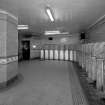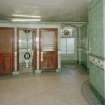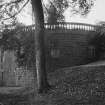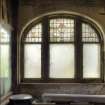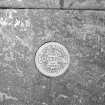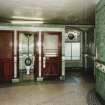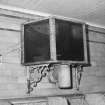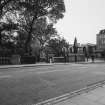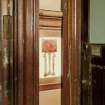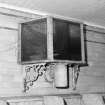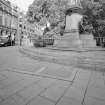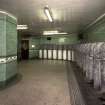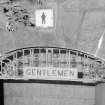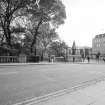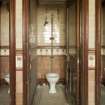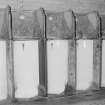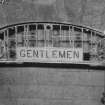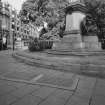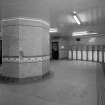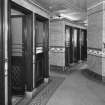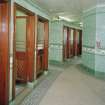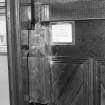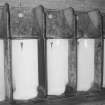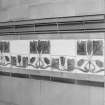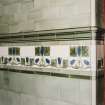Aberdeen, Union Terrace Gardens, Public Toilets
Public Convenience (19th Century)
Site Name Aberdeen, Union Terrace Gardens, Public Toilets
Classification Public Convenience (19th Century)
Alternative Name(s) Statue To King George Vi; Union Street; Union Terrace
Canmore ID 184358
Site Number NJ90NW 188.02
NGR NJ 93912 06106
Datum OSGB36 - NGR
Permalink http://canmore.org.uk/site/184358
- Council Aberdeen, City Of
- Parish Aberdeen
- Former Region Grampian
- Former District City Of Aberdeen
- Former County Aberdeenshire
NJ90NW 188.02 93912 06106
The gentlemen's public toilets at Union Terrace Gardens stand directly beneath the statue to King George VI at NGR NJ 9391 0610. They are not marked on the OS plan NJ9306SE, dated 1967.
Information from RCAHMS (DHR), May 2001.
During October 2000, RCAHMS conducted a photographic survey of the gentlemen's public toilets at Union Terrace Gardens. The purpose of this survey was to enhance and augment the National Monuments Record Scotland. At the time of the survey the toilets were still open for public use, though they were threatened with closure and redevelopment.
Visited by RCAHMS (MKO), October 2000.
A very fine Gentlemen's public convenience situated beneath the corner of Union Terrace and Union Street, with access via stairs also leading to Union Terrace Gardens.
At the time of the RCAHMS photographic survey, this facility was threatened with closure, and despite still being in use, was in a poor condition. However, its original spendour was still very evident, and many of its fittings and much of its decor were comparable with those at Rotheway Pier's gentlemen's toilets on the Island of Bute.
The principal features worthy of note were a curved range of 23 stall urinals made by Doulton of Lambeth (London) and Paisley (Renfrewshire), each with simulated grey marble tops and wings. Many of the Doulton nameplates survived. One of at least three glass-fronted cisterns (mounted on ornate cast-iron brackets) also survived, the others having been replaced by more modern units.
The facility was also equipped with two blocks of three cubicles, and a further pair of cubicles in the east corner. Most of these retained coin-operated brass locks, although most were not operational. All the original water closets and cisterns in the cubicles appeared to have been replaced. As well as an attendant's office, there was a door to an annex, but access to this room was not possible at the time of survey.
In addition to the fixtures, much of the decor had survived reasonably intact, and was dominated by glazed pale green wall tiles, with bands of decorative tiles beneath a moulded dado, and ornate moulded tiles forming a cornice at the wallhead around the blocks of toilet cubicles. These were augmented by plain cream ceiling tiles, and a mosaic-effect 'Granolite' floor.
Illumination was provided predominantly by fluorescent strip lights, assisted by windows facing the park, the upper panes of which comprised original stained glass. In addition, there were two multi-paned rectangular re-inforced glass 'Lenscrete' skylights providing light through the Union Street pavement above.
Visited by RCAHMS (MKO), October 2000.
A very fine Gentlemen's public convenience situated beneath the corner of Union Terrace and Union Street, with access via stairs also leading to Union Terrace Gardens.
At the time of survey, this facility was threatened with closure, and despite still being in use, was in a poor condition. However, its original spendour was still very evident, and many of its fittings and much of its decor were comparable with those at Rotheway Pier's gentlemen's toilets on the Island of Bute.
The principal features worthy of note were a curved range of 23 stall urinals made by Doulton of Lambeth (London) and Paisley (Renfrewshire), each with simulated grey marble tops and wings. Many of the Doulton nameplates survived. One of at least three glass-fronted cisterns (mounted on ornate cast-iron brackets) also survived, the others having been replaced by more modern units.
The facility was also equipped with two blocks of three cubicles, and a further pair of cubicles in the east corner. Most of these retained coin-operated brass locks, although most were not operational. All the original water closets and cisterns in the cubicles appeared to have been replaced. As well as an attendant's office, there was a door to an annex, but access to this room was not possible at the time of survey.
In addition to the fixtures, much of the decor had survived reasonably intact, and was dominated by glazed pale green wall tiles, with bands of decorative tiles beneath a moulded dado, and ornate moulded tiles forming a cornice at the wallhead around the blocks of toilet cubicles. These were augmented by plain cream ceiling tiles, and a mosaic-effect 'Granolite' floor.
Illumination was provided predominantly by fluorescent strip lights, assisted by windows facing the park, the upper panes of which comprised original stained glass. In addition, there were two multi-paned rectangular re-inforced glass 'Lenscrete' skylights providing light through the Union Street pavement above.
Information from RCAHMS
(MKO) 2000
Former public toilets under a semi-elliptically arched arcade that bears the footpath of Union Terrace above. The toilets retain some fine interiors. (Historic Scotland)








































